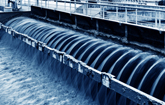DUBLIN, May 6, 2021 /PRNewswire/ -- The "Drinking Water Adsorbents Market Forecast to 2027 - COVID-19 Impact and Global Analysis - by Product (Zeolite, Clay, Activated Alumina, Activated Carbon, Manganese Oxide, Cellulose, Others)" report has been added to ResearchAndMarkets.com's offering.
The global drinking water adsorbents market was valued at US$ 511.81 million in 2019 and is projected to reach US$ 698.17 million by 2027; it is expected to grow at a CAGR of 4.0% from 2020 to 2027.
Adsorbent materials possess the capability to absorb another substance. Adsorbents are extensively used to treat and remove impurities from drinking water, and they help in enhancing the overall water quality. The stringent regulations pertaining to water quality backed by initiatives taken by government to invest in water treatment industries promote the demand for drinking water adsorbents. Further, rapid urbanization coupled with economic growth and rising demand for bio-adsorbents are driving the growth of the drinking water adsorbents market.
Based on product, the drinking water adsorbents market is segmented into zeolite, clay, activated alumina, activated carbon, manganese oxide, cellulose, and others. The activated carbon segment led the market with the largest share in 2019. The market growth for this segment is attributed to the rising adoption of these material in removal of organic contaminants. Activated carbon is composed of a family of substances along with several types of carbonaceous materials that possess adsorptive properties. These materials exhibit rare physical properties that help in minimizing dissolved contaminants along with the taste and odor, color, and toxic impurities. Strict government regulations along with significant focus on research & development activities are expected to bolster the demand for activated carbon in global market during the forecast period.
By region, the drinking water adsorbents market is segmented into North America, Europe, Asia Pacific (APAC), South America (SAM), and Middle East & Africa (MEA). In 2019, North America contributed to the largest share in the market. The market growth in this region is primarily attributed to the presence of strong industrial base along with prominent manufactures significantly contributing to market growth, rapid urbanization, and surge in demand for fresh and portable water. The easy accessibility and availability of raw materials is yet another factor that propels the drinking water adsorbents market in North America.
The COVID-19 outbreak pandemic is adversely affecting economies and industries in various countries due to government-imposed lockdowns and travel bans, and business shutdowns. The chemical & materials is one of the major industries suffering serious disruptions such as supply chain breaks, technology events cancellations, and office shutdowns. The shutdown of various plants and factories in North America, Europe, Asia Pacific, South America, and the Middle East and Africa has restricted the global supply chain and negatively impacted the manufacturing activities, delivery schedules, and product sales. Furthermore, various companies have already predicted possible delays in product deliveries and slump in future sales of their products. The travel bans imposed by countries in Europe, Asia, and North America are hindering the business collaborations and partnerships opportunities. All these factors are hampering activities in the chemical & materials industry, which are restraining the growth of various markets related to this industry.
BASF SE; CYCLOPURE INC; DuPont de Nemours, Inc; Geh Wasserchemie; Kuraray Co. Ltd; Evoqua Water Technologies LLC; KMI Zeolite; Lenntech B.V; Purolite, and Tigg LLC are among the major players operating in the global drinking water adsorbents market.
The overall global drinking water adsorbents market size has been derived in accordance with to both primary and secondary sources. To begin the research process, exhaustive secondary research has been conducted using internal and external sources to obtain qualitative and quantitative information related to the market. Also, multiple primary interviews have been conducted with industry participants and commentators to validate the data, as well as to gain more analytical insights into the topic. The participants of this process include industry experts such as VPs, business development managers, market intelligence managers, and national sales managers, along with external consultants such as valuation experts, research analysts, and key opinion leaders, specializing in the global drinking water adsorbents market.
Reasons to Buy
- Highlights key business priorities to assist companies realign their business strategies.
- Features key findings and crucial progressive industry trends in the global drinking water adsorbents market, thereby allowing players to develop effective long-term strategies.
- Develops/modifies business expansion plans by using substantial growth offering from developed and emerging markets.
- Scrutinizes in-depth market trends as well as key market drivers and restraints.
- Enhances the decision-making process by understanding the strategies that underpin commercial interest with respect to products, segmentation, and industry verticals.
Key Topics Covered:
1. Introduction
2. Key Takeaways
3. Research Methodology
4. Drinking Water Adsorbents Market Landscape
4.1 Market Overview
4.2 PEST Analysis
4.2.1 North America
4.2.2 Europe
4.2.3 APAC
4.2.4 MEA
4.2.5 SAM
4.3 Expert Opinion
4.4 PFAS Water Pollution Problem and Potential Solutions
4.4.1 PFAS Overview and Water Pollution Problem
4.4.2 Potential Solutions To Address PFAS Contamination
5. Drinking Water Adsorbents Market - Key Market Dynamics
5.1 Market Drivers
5.1.1 Growing Demand for Activated Carbon
5.1.2 Favourable Government Initiatives Regarding Drinking Water
5.2 Market Restraints
5.2.1 Availability of Substitutes
5.3 Market Opportunities
5.3.1 Rice Husk Derived Adsorbents for Water Purification
5.4 Future Trends
5.4.1 Adoption of Bio-Based Adsorbents
5.5 Impact Analysis of Drivers and Restraints
6. Drinking Water Adsorbents - Global Market Analysis
6.1 Drinking Water Adsorbents Market Overview
6.2 Drinking Water Adsorbents Market -Revenue and Forecast to 2027 (US$ Million)
6.3 Market Positioning - Global Market Players
7. Drinking Water Adsorbents Market Analysis - By Product
7.1 Overview
7.2 Drinking Water Adsorbents Market, By Product (2019 and 2027)
7.3 Zeolite
7.3.1 Overview
7.3.1.1 Zeolite: Drinking Water Adsorbents Market - Revenue, and Forecast to 2027 (US$ Million)
7.4 Clay
7.4.1 Overview
7.4.1.1 Clay: Drinking Water Adsorbents Market - Revenue, and Forecast to 2027 (US$ Million)
7.5 Activated Alumina
7.5.1 Overview
7.5.1.1 Activated Alumina: Drinking Water Adsorbents Market - Revenue, and Forecast to 2027 (US$ Million)
7.6 Activated Carbon
7.6.1 Overview
7.6.1.1 Activated Carbon: Drinking Water Adsorbents Market - Revenue, and Forecast to 2027 (US$ Million)
7.7 Manganese Oxide
7.7.1 Overview
7.7.1.1 Manganese Oxide: Drinking Water Adsorbents Market - Revenue, and Forecast to 2027 (US$ Million)
7.8 Cellulose
7.8.1 Overview
7.8.1.1 Cellulose: Drinking Water Adsorbents Market - Revenue, and Forecast to 2027 (US$ Million)
7.9 Others
7.9.1 Overview
7.9.1.1 Others: Drinking Water Adsorbents Market - Revenue, and Forecast to 2027 (US$ Million)
8. Drinking Water Adsorbents Market - Geographic Analysis
8.1 Overview
8.2 North America: Drinking Water Adsorbents Market
8.3 Europe: Drinking Water Adsorbents Market
8.4 Asia-Pacific: Drinking Water Adsorbents Market
8.5 MEA: Drinking Water Adsorbents Market
8.6 SAM: Drinking Water Adsorbents Market
9. Impact of COVID-19 Pandemic on Global Drinking Water Adsorbents Market
9.1 Overview
9.2 North America: Impact Assessment of COVID-19 Pandemic
9.3 Europe: Impact Assessment of COVID-19 Pandemic
9.4 Asia-Pacific: Impact Assessment of COVID-19 Pandemic
9.5 Middle East and Africa: Impact Assessment of COVID-19 Pandemic
9.6 South America: Impact Assessment of COVID-19 Pandemic
10. Company Profiles
10.1 BASF SE
10.1.1 Key Facts
10.1.2 Business Description
10.1.3 Products and Services
10.1.4 Financial Overview
10.1.5 SWOT Analysis
10.2 Cyclopure Inc.
10.2.1 Key Facts
10.2.2 Business Description
10.2.3 Products and Services
10.2.4 Financial Overview
10.2.5 SWOT Analysis
10.2.6 Key Developments
10.3 Dupont
10.3.1 Key Facts
10.3.2 Products and Services
10.3.3 Financial Overview
10.3.4 SWOT Analysis
10.4 KURARAY CO. LTD
10.4.1 Key Facts
10.4.2 Business Description
10.4.3 Products and Services
10.4.4 Financial Overview
10.4.5 SWOT Analysis
10.5 Geh Wasserchemie
10.5.1 Key Facts
10.5.2 Business Description
10.5.3 Products and Services
10.5.4 Financial Overview
10.5.5 SWOT Analysis
10.6 Evoqua Water Technologies LLC
10.6.1 Key Facts
10.6.2 Business Description
10.6.3 Products and Services
10.6.4 Financial Overview
10.6.5 SWOT Analysis
10.7 KMI ZEOLITE
10.7.1 Key Facts
10.7.2 Business Description
10.7.3 Products and Services
10.7.4 Financial Overview
10.7.5 SWOT Analysis
10.8 Lenntech B.V.
10.8.1 Key Facts
10.8.2 Business Description
10.8.3 Products And Services
10.8.4 Financial Overview
10.8.5 Swot Analysis
10.9 Purolite
10.9.1 Key Facts
10.9.2 Business Description
10.9.3 Products And Services
10.9.4 Financial Overview
10.9.5 Swot Analysis
10.10 TIGG LLC
10.10.1 Key Facts
10.10.2 Business Description
10.10.3 Products And Services
10.10.4 Financial Overview
10.10.5 Swot Analysis
11. Appendix
For more information about this report visit https://www.researchandmarkets.com/r/x7793y
Media Contact:
Research and Markets
Laura Wood, Senior Manager
[email protected]
For E.S.T Office Hours Call +1-917-300-0470
For U.S./CAN Toll Free Call +1-800-526-8630
For GMT Office Hours Call +353-1-416-8900
U.S. Fax: 646-607-1907
Fax (outside U.S.): +353-1-481-1716
SOURCE Research and Markets

Related Links
WANT YOUR COMPANY'S NEWS FEATURED ON PRNEWSWIRE.COM?
Newsrooms &
Influencers
Digital Media
Outlets
Journalists
Opted In




Share this article